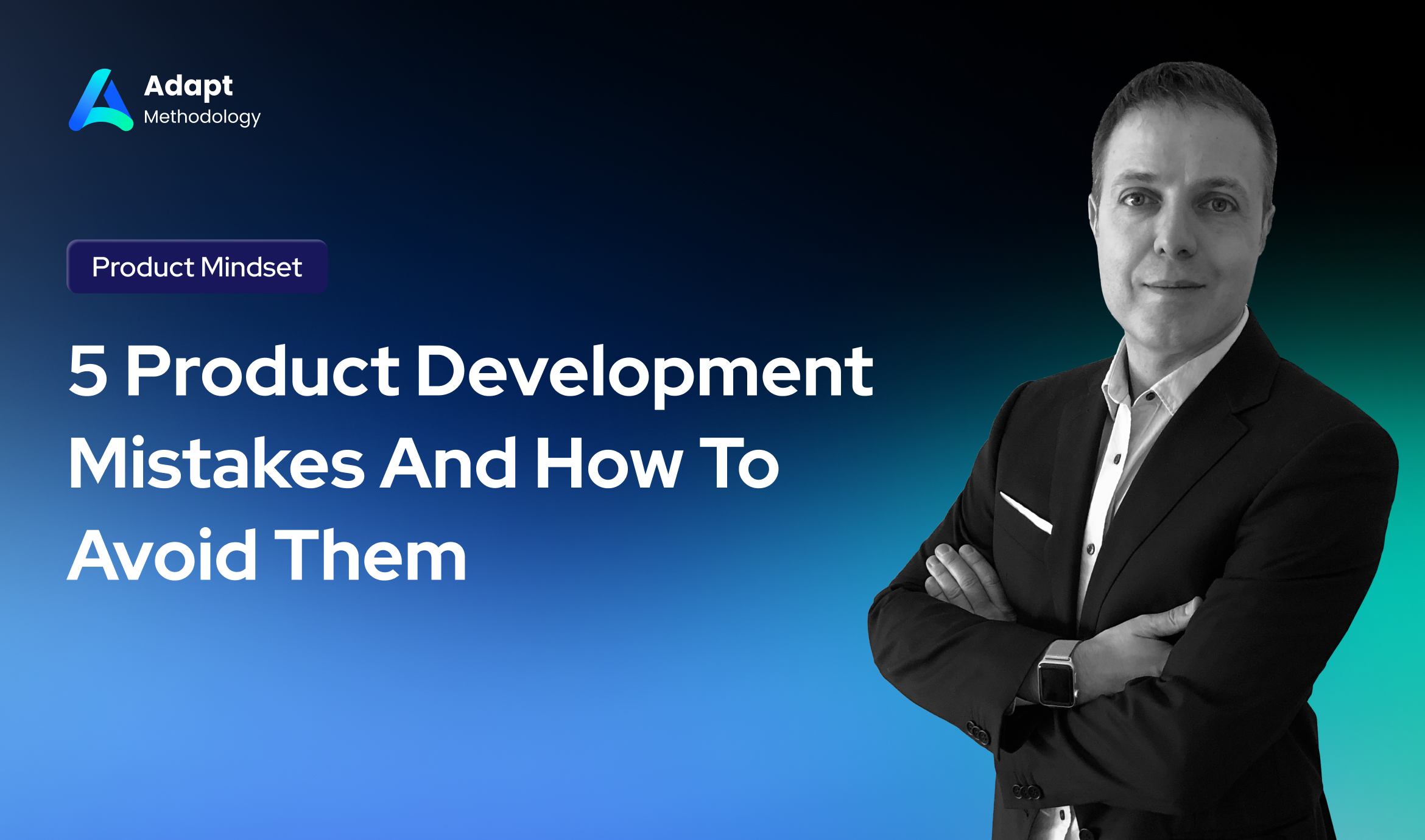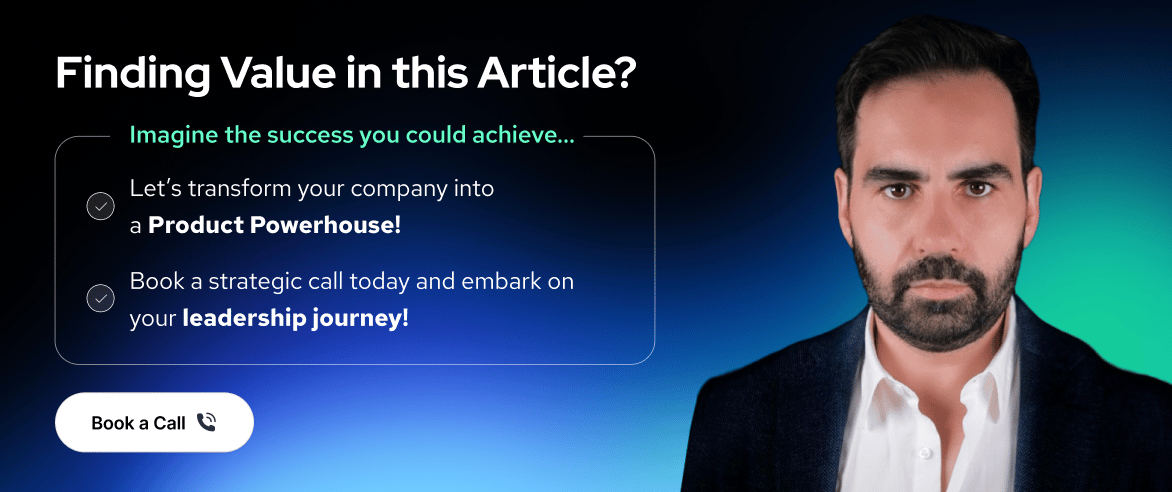Share this
5 Product Development Mistakes And How To Avoid Them
by Gerard Chiva on Jan 13, 2024 6:15:03 AM

Executives like you are worried about the major product development mistakes their companies make that stop them from becoming market leaders in the digital era and attaining the growth level they want. This article will tell you about five major product development mistakes, in case you are interested in digital product management we have a nice blog post for you: Lean Product Management.
Sadly, these product development mistakes have devastating effects on a company’s ability to deliver products with a high acceptance rate in the market. It is no longer news that within 40% – 50% of products fall short of their market acceptance expectations. So what are these five product development mistakes and how can you avoid them?
The 5 Product Development Mistakes
-
Organisational Design
One of the key reasons why many companies are unsuccessful in product development is their organizational design. Many businesses are organized around egos and silos instead of creating value.
There are three essential organizational design patterns. Two of them aren’t functioning. They can stop your business from providing optimal customer satisfaction fast. Also, they can make things difficult to maintain to make your business grow to the extent of becoming a market leader in the digital era.
Organizational Pattern 1: Proxy Product Managers
In this case, the Business Unit requests that Product Managers deliver on a Business Case that has already been enhanced. As such, Product Managers have the responsibility of coordinating the high-level delivery blueprint while Product Owners and their teams manage the in-depth backlog.
All the more so, if you’re into Agile as a team, it is characterized by sequential stages and a fixed plan of work, with silos and hand-offs division of tasks, and wishful thinking. Several businesses claim they are into Agile and it’s because their teams are into Scrum or can deliver software repeatedly and increasingly every other week.
Organizational Pattern 2 – Proxy Product Owners
This pattern evolved as an improvement to the previous pattern. Nonetheless, rather than have different roles in its delivery function, it only has one and that’s the Product Owner. Though it’s still a delivery role.
Organizational Pattern 3 – Product Organisation
In this scenario, the Product Managers are responsible for product development or product line development.
The Product Manager is responsible for leading a small team of committed people that:
- Designs the product concept
- Creates the business case
- Heads the technical design of the product
- Manages the development process
- Works with production engineers, sales/marketing and
- Oversees the product into production
If your company or business has adopted pattern 1 or 2, you’re already using the wrong pattern. You will end up delivering products no one is interested in and you’ll be caught up in a lot of challenges as time goes on.
-
Cognitive Biases
As a result of automatism in the human brain, there are up to 150 cognitive biases that make humans make illogical decisions. The key method of preventing those biases from affecting the product development process is to repeat and execute short feedback loops provided by customers and use data to make rational decisions.
A lot of cognitive biases hurt how companies define their strategy and review new ideas before executing them. The most significant ones are Innovator Bias and Confirmation Bias. But you can easily avoid both when you implement the right processes.
Innovator Bias
It’s easy for people to fall in love with their ideas or solutions without ascertaining the problems such ideas and solutions can solve. New technologies or inventions must be able to solve problems.
But a great idea that runs across your mind while you’re having a warm bath may not accurately transform into a new growth trend for your business. To make the idea effective, you’ll have to solve several different interconnected variables.
You may have a great idea like Steve Jobs or Henry Ford. But many customers don’t know what they want.
However, in this scenario when you have such a great idea, you should review it all over to figure out the actual problem that idea can solve.
You should also ensure that there’s a market that is big enough for you to build a business model with it.
Even more, you should ascertain that your solution is different from present solutions and competition by creating a unique value proposition (USP) for your brand. These are the key things you’ll have to do repeatedly and increasingly by implementing the scientific approach and testing your most risky assumptions over and over again until you get a hold of the market.
Confirmation Bias
This refers to the possibility that people look for, interpret, and remember information that affirms their beliefs and opinions. Confirmation bias occurs when people give more significance to evidence that affirms their hypothesis and downplays evidence that could show it is false.
-
Putting The Cart Before The Horse
This is one of the most common product development mistakes many traditional companies make. Many companies scale before they have any objective that you have developed a product people want and there’s an actual market for whatever you’re offering (Product-Market Fit).
Oftentimes, when there’s an idea, goal, or project, companies design a business model all of a sudden and provide funds for the project based on assumptions, estimates, and future predictions. They put the entire resources, infrastructure, and workforce together upfront, and then, they start building outrageously.
Whenever executives like you have to work with traditional businesses, they often ask their clients to view product development the same way they approach innovation or startups. Management should take up responsibilities like Venture Capitalists.
They should also use innovation accounting to evaluate progress until their solution is ripe enough for Product-Market Fit and then focus on growth.
- You shouldn’t hire 15 developers if you’re yet to ascertain product-market fit.
- You shouldn’t assign a budget for the year to projects and products from the first day.
- You shouldn’t bother about creating a scalable architecture from the first day. Allow your infrastructure to grow with your customer base. Or else, you may end up spending a lot of money on things you don’t need.
Some business owners are also known for making the mistake of scaling their businesses before they achieve Product-Market Fit. Such an approach is a big mistake because scaling is expensive and it requires constant funding. If you scale without having a product-market fit, you’ve made a terrible mistake.
Because of the way many traditional companies operate, assign resources, budget and offer an incentive to management, it stops them from working this way. As a result, it affects their operation and eventually makes them insignificant.
-
Simply Because You Can Build It
Many companies are always too eager to start building before making up their mind on the problems they want to solve, for whom, and if there’s an existing market that is big enough and willing to pay for their solutions. This is one of the most common patterns of the waterfall of so many agile businesses to date.
This problem is an attitude of delivery. An attitude of output over results. In this scenario, their ultimate challenge is to move the working software to the production phase regardless of its ability to solve any problem or provide solutions or not. The entire process is similar to a feature factory.
In this case, the company is not even aware if there’s any problem that deserves a solution and if their product can solve the problem or not. All they know is that they are building software. Don’t forget that building software can be one of the most expensive things your business will do. So do everything possible to reduce the cost of building the software. In this case, the Agile principle of “working software is the primary measure of progress” is not applicable. Rather, the only measure of progress, in this case, is validated learning.
Several companies also make the mistake of considering whether to make an investment or execute a project based on its cost. Unknown to them, cost is one of the less important variables among all the variables in a business model. In most cases, the most crucial variables include the market size and the product adoption rate.
So rather than ask how much it’s going to cost to build or implement a software or project, you should ask how much you’re going to sell and how fast.
Similarly, just because you can design or build software doesn’t mean you should go ahead and build one. Rather, you should ask yourself several different questions including:
- What problem will it solve?
- Who will use it and how many are they?
- What alternative exists in the market?
- What price should we sell in order to make profits?
- Are our target customers willing to pay such price?
- What are the operational and technological effects of the price?
- And other related questions.
-
Wishful Thinking
This simply means operating or running a business blindly or making crucial decisions without using any data. Many companies and businesses are guilty of this mistake and it occurs anywhere from strategy to operations. Many investment decisions are made as a result of about 50-page business cases that are made up of false data and assumptions.
In many cases, there’s no framework for deciding what project deserves funding or not, and more often than not, the HIPPO has to make the eventual decision.
Product Managers and Product Owners often schedule their work based on what seems to be an urgent need, opinion, or perhaps the situation that makes the loudest call.
Did you like this article?
We enable leaders to become highly valued and recognized to make an impact on the World by helping them to design Digital Product Companies that will thrive and nourish in the Digital Age, we do this by applying our own ADAPT Methodology®.
If you are interested in knowing if you have what it takes to design and build a great digital product company simply take our Digital Leadership Influence Scorecard.
If you want to know how we can help you to start your transformation please check out our: Training.
If you are interested in doing a transformation in your company please check out our: Consulting.
Share this
- Agile Methodologies (18)
- Product Strategy (18)
- OKRs (16)
- Scrum (16)
- Product Mindset (14)
- Project To Product (10)
- Agile Retrospectives (9)
- CoPs (9)
- Knowledge Sharing (9)
- Time To Market (8)
- Product Discovery (7)
- Continuous Improvement (5)
- Strategy (5)
- Scrum Master (4)
- Content Marketing Strategy (3)
- Product Owner (3)
- Technical Excellency (3)
- Digital Transformation (2)
- Innovation (2)
- Scaling (2)
- Team Building (2)
- Business Model (1)
- Cost Of Delay (1)
- Customer Feedback (1)
- Customer Journey (1)
- Customer Personas (1)
- Design Thinking (1)
- Digital Leadership (1)
- Digital Product Tools (1)
- Go To Market Strategy (1)
- Google Design Sprint (1)
- Lean Budgeting (1)
- Lean Change Management (1)
- Market Solution Fit (1)
- Organisational Impediments (1)
- Outsourcing (1)
- Product (1)
- Product Metrics (1)
- Product Roadmaps (1)

Organisational Mastery
Get your free copy

ADAPT
Get your free copy

Product First
Get your free copy

